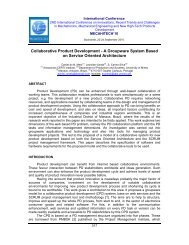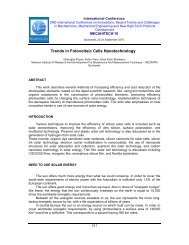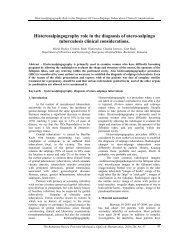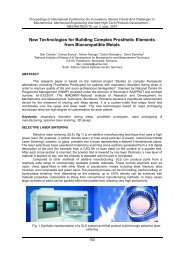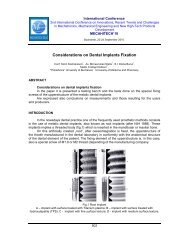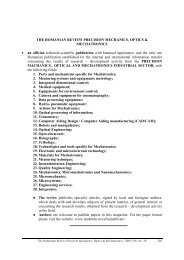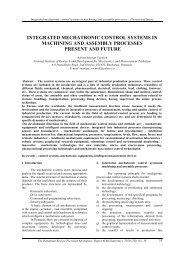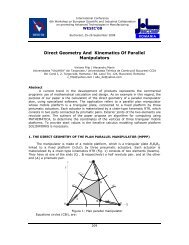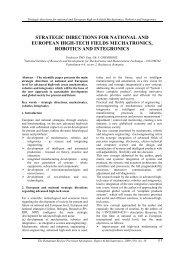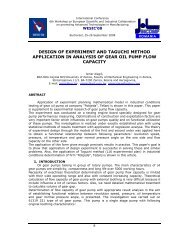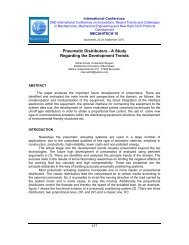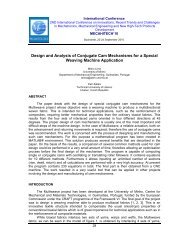The new generation of rapid prototyping technology in - incdmtm
The new generation of rapid prototyping technology in - incdmtm
The new generation of rapid prototyping technology in - incdmtm
You also want an ePaper? Increase the reach of your titles
YUMPU automatically turns print PDFs into web optimized ePapers that Google loves.
<strong>The</strong> <strong>new</strong> <strong>generation</strong> <strong>of</strong> <strong>rapid</strong> <strong>prototyp<strong>in</strong>g</strong> <strong>technology</strong> <strong>in</strong> selective laser s<strong>in</strong>ter<strong>in</strong>g for metal powders<br />
THE NEW GENERATION OF RAPID PROTOTYPING<br />
TECHNOLOGY IN SELECTIVE LASER SINTERING FOR<br />
METAL POWDERS<br />
Pr<strong>of</strong>. Univ. Dr. Ing. Gh. Ion Gheorghe 1 , Drd. Ing. Ciobota Nastase-Dan 1 , Pr<strong>of</strong>. Dr. Igor Drstvensek 2<br />
1 National Institute <strong>of</strong> Research and Development for Mechatronics and Measurement Technique<br />
Sos. Pantelimon 6-8, Sector 2, 021631, Bucuresti, Romania<br />
2 University <strong>of</strong> Maribor, Faculty <strong>of</strong> Mechanical Eng<strong>in</strong>eer<strong>in</strong>g, Slovenia<br />
Abstract – In this paper will be presented a <strong>new</strong><br />
<strong>technology</strong>, us<strong>in</strong>g <strong>new</strong> materials especially<br />
designed for complex geometries, extensively used<br />
<strong>in</strong> research-development and <strong>in</strong>novation area.<br />
Even highly complex geometries are created<br />
directly from 3D CAD data, fully automatically, <strong>in</strong><br />
just a few hours and without any tool<strong>in</strong>g. It is a<br />
net-shape process, produc<strong>in</strong>g parts with high<br />
accuracy and detail resolution, good surface<br />
quality and excellent mechanical properties.<br />
NATIONAL INSTITUTE OF RESEARCH<br />
AND DEVELOPMENT FOR MECATRONICS<br />
AND MEASUREMENT TECHNIQUE<br />
Keywords – mechatronics, biomechanics, <strong>rapid</strong><br />
<strong>prototyp<strong>in</strong>g</strong>, <strong>new</strong> materials and alloys, 3D<br />
modell<strong>in</strong>g, CT scann<strong>in</strong>g<br />
1. Introduction<br />
In this paper will be presented a <strong>new</strong> <strong>technology</strong>,<br />
us<strong>in</strong>g <strong>new</strong> materials especially designed for complex<br />
geometries, extensively used <strong>in</strong> research-development<br />
and <strong>in</strong>novation area. In order to do this we will go<br />
through presentation <strong>of</strong> the basic pr<strong>in</strong>ciples for the<br />
<strong>rapid</strong> <strong>prototyp<strong>in</strong>g</strong> <strong>technology</strong>, materials and<br />
capabilities.<br />
This <strong>technology</strong> use the EOSINT M270 mach<strong>in</strong>e,<br />
which is an laser-s<strong>in</strong>ter<strong>in</strong>g system for the production<br />
<strong>of</strong> tool<strong>in</strong>g <strong>in</strong>serts, prototype parts and end products<br />
directly <strong>in</strong> metal.<br />
Laser-s<strong>in</strong>ter<strong>in</strong>g is the key <strong>technology</strong> for e-<br />
Manufactur<strong>in</strong>g.<br />
<strong>The</strong> implementation <strong>of</strong> this technolgy took place<br />
on Biomechatronics Department <strong>in</strong> National Institute<br />
<strong>of</strong> Research and Development for Mechatronics and<br />
Measurement Technique, Bucharest, Romania.<br />
<strong>The</strong> Laser-S<strong>in</strong>ter<strong>in</strong>g System for metal powder is<br />
<strong>in</strong> conformity with the provisions <strong>of</strong> the European<br />
Union as follows:<br />
- Mach<strong>in</strong>ery Directive 98/37/EC, Annex II A;<br />
- Low Voltage Directive 73/23/ECC;<br />
- EMC Directive 89/336/ECC.<br />
We were the first Romanian entity to <strong>in</strong>stall<br />
DMLS equipment, and yearly demand for lasers<strong>in</strong>ter<strong>in</strong>g<br />
services has <strong>in</strong>creased. We expect <strong>in</strong>terest<br />
<strong>in</strong> titanium parts to follow the same strong demand<br />
curve.<br />
S<strong>in</strong>ce 2007, INCDMTM work to identify<br />
product applications and <strong>in</strong>troduce our systems to the<br />
manufactur<strong>in</strong>g <strong>in</strong>dustry.<br />
With the purchase <strong>of</strong> this <strong>new</strong> titanium-based<br />
system, INCDMTM stays among the lead<strong>in</strong>g<br />
suppliers who are will<strong>in</strong>g to explore DMLS (Direct<br />
Metal Laser S<strong>in</strong>ter<strong>in</strong>g) and the breakthroughs it holds<br />
for <strong>in</strong>novative companies.<br />
<strong>The</strong> EOSINT M 270 system uses laser-s<strong>in</strong>ter<strong>in</strong>g<br />
to additively manufacture parts layer-by-layer. A<br />
range <strong>of</strong> metal materials is available, <strong>in</strong>clud<strong>in</strong>g steels,<br />
cobalt- and nickel-based superalloys and titanium<br />
alloys. EOS Titanium Ti64 is a pre-alloyed Ti6AL4V<br />
alloy with excellent mechanical properties and<br />
corrosion resistance, low specific weight, and<br />
biocompatibility.<br />
Parts built from this alloy can be mach<strong>in</strong>ed,<br />
spark-eroded, welded, micro shot-peened, polished<br />
and coated as needed. Typical uses <strong>in</strong>clude dental,<br />
orthopedic, and airframe applications.<br />
<strong>The</strong> Romanian Review Precision Mechanics, Optics & Mechatronics, 2009 (19), No. 35 105
<strong>The</strong> <strong>new</strong> <strong>generation</strong> <strong>of</strong> <strong>rapid</strong> <strong>prototyp<strong>in</strong>g</strong> <strong>technology</strong> <strong>in</strong> selective laser s<strong>in</strong>ter<strong>in</strong>g for metal powders<br />
We are also very pleased to become cooperation<br />
with one <strong>of</strong> the EU country, namely with Slovenia.<br />
Pr<strong>of</strong>. Dr. Igor Drstvensek from University <strong>of</strong><br />
Maribor, Faculty <strong>of</strong> Mechanical Eng<strong>in</strong>eer<strong>in</strong>g<br />
established a wide cooperation between mechanical<br />
and medical research fields and develop several<br />
methods for custom implant production that helped<br />
surgeons to shorten the operat<strong>in</strong>g time and rise the<br />
outcome probabilities with better preoperative<br />
plann<strong>in</strong>g.<br />
Together, we want to create an excellence<br />
research centre with a favourable climate for research<br />
and development <strong>of</strong> <strong>new</strong> technologies l<strong>in</strong>ked to<br />
medical imag<strong>in</strong>g, 3D geometric modell<strong>in</strong>g <strong>of</strong> osteoarticular<br />
structures, computer-assisted surgery and<br />
quantitative assessment <strong>of</strong> orthopaedic and surgical<br />
corrective methods.<br />
Metal parts directly from CAD data<br />
A number <strong>of</strong> different materials are available for<br />
use with EOSINT M systems, <strong>of</strong>fer<strong>in</strong>g a broad range<br />
<strong>of</strong> e-Manufactur<strong>in</strong>g applications. EOS CobaltChrome<br />
MP1 is a multi-purpose cobaltchrome-molybdenumbased<br />
superalloy powder which has been optimized<br />
especially for process<strong>in</strong>g on EOSINT M 270<br />
systems. Other materials are also available for<br />
EOSINT M systems, <strong>in</strong>clud<strong>in</strong>g a special-purpose<br />
cobalt-chrome-molybdenum-based superalloy for<br />
dental veneer<strong>in</strong>g application, and further materials<br />
are cont<strong>in</strong>uously be<strong>in</strong>g developed - please refer to the<br />
relevant material data sheets for details.<br />
<strong>The</strong> ability to produce such parts very quickly<br />
enables flexible and economic manufacture <strong>of</strong><br />
<strong>in</strong>dividual parts or batches, which <strong>in</strong> turn enables<br />
design or manufactur<strong>in</strong>g problems to be identified at<br />
an early stage <strong>of</strong> product development and time to<br />
market to be shortened.<br />
This <strong>new</strong> <strong>technology</strong> is used <strong>in</strong> top doma<strong>in</strong>s <strong>of</strong><br />
eng<strong>in</strong>eer<strong>in</strong>g and medic<strong>in</strong>e, both for civil and military<br />
purposes. <strong>The</strong> most advanced eng<strong>in</strong>eer<strong>in</strong>g entity,<br />
National Aeronautics and Space Adm<strong>in</strong>istration<br />
(NASA), use the EOSINT M270 mach<strong>in</strong>e, Titanium<br />
Version.<br />
2. Categories <strong>of</strong> metal powders that can be used<br />
2.1 Superalloy EOS CobaltChrome MP1 for<br />
EOSINT M 270<br />
EOS CobaltChrome MP1 is a f<strong>in</strong>e powder mixture<br />
for process<strong>in</strong>g on EOSINT M 270 systems, which<br />
produces parts <strong>in</strong> a cobalt-chrome-molybdenumbased<br />
superalloy. This class <strong>of</strong> superalloy is<br />
characterized by hav<strong>in</strong>g excellent mechanical<br />
properties (strength, hardness etc.), corrosion<br />
resistance and temperature resistance. Such alloys are<br />
commonly used <strong>in</strong> biomedical applications such as<br />
dental and medical implants (note: widely used <strong>in</strong><br />
Europe but much less so <strong>in</strong> North America), and also<br />
for high-temperature eng<strong>in</strong>eer<strong>in</strong>g applications such as<br />
<strong>in</strong> aero eng<strong>in</strong>es.<br />
Figure 1. Example <strong>of</strong> EOSINT M270 parts build for<br />
<strong>in</strong>dustry <strong>in</strong> INCDMTM<br />
<strong>The</strong> chemistry <strong>of</strong> EOS CobaltChrome MP1<br />
conforms to the composition UNS R31538 <strong>of</strong> high<br />
carbon CoCrMo alloy. Parts built from this material<br />
are nickel-free (< 0.1 % nickel content), sterilisable<br />
and suitable for biomedical applications, and are<br />
characterized by a f<strong>in</strong>e, uniform crystal gra<strong>in</strong><br />
structure. <strong>The</strong>y fully meet the requirements <strong>of</strong> ISO<br />
5832-4 and ASTM F75 for cast CoCrMo implant<br />
alloys, as well as the requirements <strong>of</strong> ISO 5832-12<br />
and ASTM F1537 for wrought CoCrMo implants<br />
alloys except rema<strong>in</strong><strong>in</strong>g elongation. <strong>The</strong> rema<strong>in</strong><strong>in</strong>g<br />
elongation can be <strong>in</strong>creased to fulfil even this<br />
standard by hot isostatic press<strong>in</strong>g (HIP).<br />
This material is ideal for many part-build<strong>in</strong>g<br />
applications (DirectPart) such as functional metal<br />
prototypes, small series products, <strong>in</strong>dividualised<br />
products or spare parts. Standard process<strong>in</strong>g<br />
parameters use full melt<strong>in</strong>g <strong>of</strong> the entire geometry<br />
with 20 μm layer thickness, but it is also possible to<br />
use the Sk<strong>in</strong> & Core build<strong>in</strong>g style to <strong>in</strong>crease the<br />
build speed. Us<strong>in</strong>g standard parameters the<br />
mechanical properties are fairly uniform <strong>in</strong> all<br />
directions. Parts made from EOS CobaltChrome MP1<br />
can be mach<strong>in</strong>ed, spark-eroded, welded, micro shotpeened,<br />
polished and coated if required. Unexposed<br />
powder can be reused.<br />
Typical applications:<br />
- prototype, one-<strong>of</strong>f or small-series biomedical<br />
implants, e.g. sp<strong>in</strong>al, knee, hip bone, toe and dental.<br />
- parts requir<strong>in</strong>g high mechanical properties <strong>in</strong><br />
elevated temperatures (500 - 1000 °C) and with good<br />
corrosion resistance, e.g. turb<strong>in</strong>es and other parts for<br />
eng<strong>in</strong>es, cutt<strong>in</strong>g parts, etc.<br />
- parts hav<strong>in</strong>g very small features such as th<strong>in</strong><br />
walls, p<strong>in</strong>s, etc., which require particularly high<br />
strength and/or stiffness.<br />
106<br />
<strong>The</strong> Romanian Review Precision Mechanics, Optics & Mechatronics, 2009 (19), No. 35
<strong>The</strong> <strong>new</strong> <strong>generation</strong> <strong>of</strong> <strong>rapid</strong> <strong>prototyp<strong>in</strong>g</strong> <strong>technology</strong> <strong>in</strong> selective laser s<strong>in</strong>ter<strong>in</strong>g for metal powders<br />
2.2 EOS CobaltChrome SP1 for EOSINT M 270<br />
EOS CobaltChrome SP1 is a cobaltchromemolybdenum-based<br />
superalloy powder which<br />
has been especially developed to fulfil the<br />
requirements <strong>of</strong> dental restorations which have to be<br />
veneered with dental ceramic material and has been<br />
optimized especially for process<strong>in</strong>g on EOSINT M<br />
270 systems. Other materials are also available for<br />
EOSINT M systems, and further materials are<br />
cont<strong>in</strong>uously be<strong>in</strong>g developed.<br />
EOS CobaltChrome SP1 is a Co, Cr, Mo and W<br />
based alloy <strong>in</strong> f<strong>in</strong>e powder form. Its composition<br />
corresponds for type 4 CoCr dental material <strong>in</strong> EN<br />
ISO 16744 standard. It also fulfills the chemical and<br />
thermal requirements <strong>of</strong> EN ISO 9693 for CoCr PFM<br />
(porcela<strong>in</strong> fused metal) <strong>of</strong> dental materials (Ni<br />
content: < 0.1 %, no Cd or Be) and requirements <strong>of</strong><br />
EN ISO 7504 and EN ISO 10993 regard<strong>in</strong>g the<br />
biocompatibility and cytoxity <strong>of</strong> the dental materials.<br />
This material is ideal for produc<strong>in</strong>g dental<br />
restorations. Standard process<strong>in</strong>g parameters use full<br />
melt<strong>in</strong>g <strong>of</strong> the entire geometry with 20 μm layer<br />
thickness.<br />
Standard process<strong>in</strong>g parameters use full melt<strong>in</strong>g <strong>of</strong><br />
the entire geometry with 20 μm layer thickness, but it<br />
is also possible to use the Sk<strong>in</strong> & Core build<strong>in</strong>g style<br />
to <strong>in</strong>crease the build speed.<br />
Typical application:<br />
- dental restorations (crowns, bridges etc.)<br />
3. <strong>The</strong> mechanical and optical unit pr<strong>in</strong>ciples <strong>of</strong><br />
the sls mach<strong>in</strong>e<br />
3.1 Mechanical Unit<br />
<strong>The</strong> mechanical unit conta<strong>in</strong>s the follow<strong>in</strong>g<br />
components:<br />
1. Recoater<br />
2. Dial gauge with bracket<br />
3. Build<strong>in</strong>g platform<br />
4. Feeler gauges (graduation 0.05 mm)<br />
5. Measur<strong>in</strong>g strip<br />
A. Adjust<strong>in</strong>g motor for adjust<strong>in</strong>g the Y-axis<br />
B. Adjust<strong>in</strong>g motor for adjust<strong>in</strong>g the X-axis<br />
Figure 3. EOSINT M – mechanical unit<br />
3.2 Optical Unit<br />
<strong>The</strong> optical unit conta<strong>in</strong>s the follow<strong>in</strong>g components:<br />
1. Scanner with protective covers<br />
2. Adjust<strong>in</strong>g knob BEAM EXPANDER<br />
ADJUSTEMENT<br />
3. Beam expander optics<br />
4. Collimator with holder and protective cover<br />
5. Laser fibre optic<br />
Figure 2. Eos<strong>in</strong>t M work<strong>in</strong>g pr<strong>in</strong>ciples<br />
EOSINT M – Advantages<br />
Net-shape metal parts created directly <strong>in</strong> one<br />
step; no b<strong>in</strong>der removal, generally no postmach<strong>in</strong><strong>in</strong>g;<br />
Very high geometric flexibility (e.g. free-forms,<br />
deep slots and curved cool<strong>in</strong>g channels);<br />
Fully automatic operation, high productivity and<br />
low personnel costs; low level <strong>of</strong> tra<strong>in</strong><strong>in</strong>g and<br />
experience necessary;<br />
Low material consumption; optimal usage <strong>of</strong><br />
material, uns<strong>in</strong>tered powder can be reused;<br />
Compatibility with other processes; parts can be<br />
milled, drilled, welded, etc.<br />
Figure 4. EOSINT M – optical unit<br />
4. Mechanical and biocompatibility properties<br />
This is only a short list, because constantly are<br />
developed <strong>new</strong> powders with <strong>in</strong>creased mechanical,<br />
physical and thermal properties.<br />
<strong>The</strong> Romanian Review Precision Mechanics, Optics & Mechatronics, 2009 (19), No. 35 107
<strong>The</strong> <strong>new</strong> <strong>generation</strong> <strong>of</strong> <strong>rapid</strong> <strong>prototyp<strong>in</strong>g</strong> <strong>technology</strong> <strong>in</strong> selective laser s<strong>in</strong>ter<strong>in</strong>g for metal powders<br />
Table 1. Categories <strong>of</strong> metal powders that can be used<br />
Material name<br />
Material type<br />
DirectMetal 20<br />
Bronze-based mixture<br />
DirectSteel H20<br />
Steel-based mixture<br />
EOS Marag<strong>in</strong>gSteel MS1 18 Mar 300 / 1.2709<br />
EOS Sta<strong>in</strong>lessSteel 17-4<br />
Sta<strong>in</strong>less steel<br />
17-4 / 1.4542<br />
EOS CobaltChrome MP1 CoCrMo superalloy<br />
EOS Titanium Ti64* Ti6Al4V light alloy<br />
EOS Titanium TiCP* Pure titanium<br />
Uses <strong>of</strong> CAD and Rapid Prototyp<strong>in</strong>g <strong>in</strong> medic<strong>in</strong>e<br />
Comb<strong>in</strong>ed with traditional CT scann<strong>in</strong>g<br />
techniques <strong>rapid</strong> technologies (<strong>prototyp<strong>in</strong>g</strong> and<br />
tool<strong>in</strong>g) can be used as <strong>in</strong>struments for better (threedimensional)<br />
visualization, simulation <strong>of</strong> procedures<br />
and treatment <strong>of</strong> patients.<br />
Figure 4. A complex example <strong>of</strong> the great quality, fidelity<br />
<strong>of</strong> shapes <strong>in</strong> maxil<strong>of</strong>acial implantolgy<br />
Titanium alloys <strong>of</strong>fer a unique comb<strong>in</strong>ation <strong>of</strong><br />
properties for many biomedical applications.<br />
Summary <strong>of</strong> important biomedical properties:<br />
- Excellent corrosion resistance,<br />
biocompatibility and bioadhesion;<br />
- Titanium and its alloys are used for many<br />
biomedical and dental applications<br />
(implants, screws, crowns...).<br />
Figure 5. Summary <strong>of</strong> important biomedical<br />
properties<br />
Titanium alloys <strong>of</strong>fer a unique comb<strong>in</strong>ation <strong>of</strong><br />
properties for many eng<strong>in</strong>eer<strong>in</strong>g applications.<br />
Summary <strong>of</strong> important eng<strong>in</strong>eer<strong>in</strong>g properties:<br />
— Light weight material with high specific strength<br />
(strength per weight)<br />
— Ti6Al4V with high strength also at elevated<br />
temperatures<br />
— <strong>The</strong> comb<strong>in</strong>ation <strong>of</strong> mechanical properties and the<br />
corrosion resistance is the basis for applications <strong>in</strong><br />
Formula 1 and aerospace.<br />
Various grades <strong>of</strong> Titanium (alloys) are commonly<br />
used <strong>in</strong> <strong>in</strong>dustrial applications.<br />
Table 2: Summary <strong>of</strong> the most important Ti materials<br />
Figure 6. Parametric model <strong>in</strong> 3D CAD - SolidWorks<br />
<strong>The</strong> CAD models, virtual model <strong>of</strong> a human<br />
body or a part <strong>of</strong> it can be used to study the<br />
problematic area before the actual operation starts.<br />
This is especially important <strong>in</strong> cases where<br />
functionality <strong>of</strong> the body part has to be re-established<br />
(orthopaedic surgery). Besides the cont<strong>in</strong>uous flow<br />
and other FEA methods that are used to calculate<br />
required mechanical and physical properties <strong>of</strong> the<br />
implant, the virtual models can also be used to study<br />
the surgical procedures, like directions <strong>of</strong><br />
implantation, required preoperational treatments and<br />
preparations, etc.<br />
Figure 7. CAD model on human vertebrae used for<br />
FEM analysis<br />
CP = commercially pure, ELI = extra-low <strong>in</strong>terstitials<br />
<strong>The</strong> easiest way to reconstruct the structure <strong>of</strong> a<br />
patient’s bones is to use those CT images that already<br />
exist from previous treatments <strong>of</strong> the patient. A set <strong>of</strong><br />
CT images can be converted <strong>in</strong>to a threedimensional,<br />
digital model us<strong>in</strong>g one <strong>of</strong> the available<br />
108<br />
<strong>The</strong> Romanian Review Precision Mechanics, Optics & Mechatronics, 2009 (19), No. 35
<strong>The</strong> <strong>new</strong> <strong>generation</strong> <strong>of</strong> <strong>rapid</strong> <strong>prototyp<strong>in</strong>g</strong> <strong>technology</strong> <strong>in</strong> selective laser s<strong>in</strong>ter<strong>in</strong>g for metal powders<br />
conversion s<strong>of</strong>tware, such as: Mimics (Materialise),<br />
RapidForm (Inus Technology), 3D doctor (Able<br />
S<strong>of</strong>tware), Amira (Marcury Computer), or others.<br />
<strong>The</strong> <strong>in</strong>put to this s<strong>of</strong>tware is usually <strong>in</strong> the form <strong>of</strong><br />
DICOM files and output is predom<strong>in</strong>antly STL<br />
(Standard Tessellation Language), which can be<br />
directly used <strong>in</strong> most RP technologies to produce real<br />
models (Figure 1).<br />
— Alternatives<br />
•can <strong>in</strong> many cases be substituted by<br />
EOS CobaltChrome MP1<br />
— Commercialization status<br />
•so far only <strong>in</strong> R&D<br />
Figure 9. Example <strong>of</strong> the complexity <strong>of</strong> the design<br />
Figure 8. CT scan used for analysis<br />
Three dimensional reconstruction <strong>of</strong> DICOM<br />
images <strong>in</strong> a form <strong>of</strong> STL file can be further<br />
manipulated by several CAD s<strong>of</strong>tware. <strong>The</strong> usual 3D<br />
modelers based on parametric, volume model<strong>in</strong>g<br />
techniques are not very well suited to the task. Newer<br />
versions <strong>of</strong> these s<strong>of</strong>tware packages (SolidWorks<br />
2008, Delcam, etc.) enable manipulation <strong>of</strong><br />
triangulated surface files, but us<strong>in</strong>g dedicated<br />
s<strong>of</strong>tware, known from Reverse Eng<strong>in</strong>eer<strong>in</strong>g fields,<br />
such as Magics (Materialise), RapidForm,<br />
PolyWorks (InnovMetric), or others is much more<br />
effective <strong>in</strong> terms <strong>of</strong> time and effort. Us<strong>in</strong>g these<br />
s<strong>of</strong>tware and STL models <strong>of</strong> scanned body parts,<br />
miss<strong>in</strong>g tissue can be modelled and saved as <strong>new</strong><br />
STL files. <strong>The</strong>se can be further processed or used for<br />
the production <strong>of</strong> real implant models by means <strong>of</strong><br />
RP or RM technologies. CAD modell<strong>in</strong>g <strong>of</strong> the<br />
implant was performed us<strong>in</strong>g several reverse<br />
eng<strong>in</strong>eer<strong>in</strong>g s<strong>of</strong>tware packages.<br />
Another <strong>in</strong>terest<strong>in</strong>g idea is to use a comb<strong>in</strong>ation<br />
<strong>of</strong> CT and RMN images.<br />
EOS has successfully produced parts <strong>in</strong> gold on<br />
EOSINT M 270.<br />
Description<br />
— Material type<br />
•precious metal, used <strong>in</strong> various purities / alloys for<br />
jewellery, electronics and dental restorations<br />
— Alternatives<br />
•currently no comparable commercial material<br />
available<br />
for EOSINT M<br />
— Commercialization status<br />
•so far only <strong>in</strong> R&D<br />
5. Technical and economical aspects; future<br />
trends<br />
EOS has successfully produced parts <strong>in</strong> Inconel<br />
alloys on EOSINT M 270.<br />
Description<br />
— Material type<br />
•nickel-based superalloy, commonly used for hightemperature<br />
eng<strong>in</strong>eer<strong>in</strong>g applications such as<br />
aerospace turb<strong>in</strong>e parts<br />
Figure 10. Example <strong>of</strong> geometrical complexity<br />
5.1 Various grades <strong>of</strong> Titanium (alloys) commonly<br />
used <strong>in</strong> <strong>in</strong>dustrial applications<br />
Under the direct supervision <strong>of</strong> EOS specialist,<br />
Dipl. Eng. Deniz Demirtas, we build an impressive<br />
amount <strong>of</strong> difficult parts for neurosurgery and<br />
<strong>The</strong> Romanian Review Precision Mechanics, Optics & Mechatronics, 2009 (19), No. 35 109
<strong>The</strong> <strong>new</strong> <strong>generation</strong> <strong>of</strong> <strong>rapid</strong> <strong>prototyp<strong>in</strong>g</strong> <strong>technology</strong> <strong>in</strong> selective laser s<strong>in</strong>ter<strong>in</strong>g for metal powders<br />
orthopaedic implants. <strong>The</strong> results were impressive.<br />
Table 3. Mechanical properties <strong>of</strong> conventional<br />
barstock<br />
Figure 11. Mechanical properties<br />
CP = commercially pure, ELI = extra-low <strong>in</strong>terstitials<br />
(*) Source: Euro-Titan Handels AG, Sol<strong>in</strong>gen,<br />
Germany<br />
EOS Titanium - light alloy materials for <strong>prototyp<strong>in</strong>g</strong><br />
and series production<br />
Characteristics and applications<br />
— Several versions will be available<br />
•EOS Titanium Ti64 (Ti6Al4V)<br />
•EOS Titanium Ti64 ELI (higher purity)<br />
•EOS Titanium TiCP (commercially pure)<br />
— Key characteristics<br />
•lightweight<br />
•high strength<br />
•biocompatibility<br />
— Typical applications<br />
•aerospace and eng<strong>in</strong>eer<strong>in</strong>g applications<br />
•biomedical implants<br />
Figure 11. Parametric cost model<br />
EOS Titanium Ti64 parts fulfil relevant<br />
<strong>in</strong>dustrial standards and relevant requirements.<br />
Physical and chemical properties:<br />
— Physical properties<br />
•laser-s<strong>in</strong>tered density: approx. 100 %<br />
•only s<strong>in</strong>gle pores<br />
— Chemical properties<br />
•laser-s<strong>in</strong>tered parts fulfil requirements <strong>of</strong> ASTM<br />
F1472 (for Ti6Al4V) and ASTM F136 (for Ti6Al4V<br />
ELI) regard<strong>in</strong>g maximum concentration <strong>of</strong> impurities<br />
• oxygen < 2000ppm or 1500ppm<br />
• nitrogen < 700ppm<br />
— Bioadhesion<br />
•cell growth tested with good results<br />
EOS Titanium Ti64 produces parts with<br />
excellent mechanical properties.<br />
Figure 12. Different types <strong>of</strong> sp<strong>in</strong>al implants from<br />
EOS<br />
EOS Titanium Ti64 produces fully dense parts<br />
with dendritic, martensitic gra<strong>in</strong> structure.<br />
Metallurgy:<br />
Typically martensitic structure with gra<strong>in</strong>s grow<strong>in</strong>g<br />
from layer to layer<br />
•preferential Z orientation<br />
•gra<strong>in</strong> size >> layer thickness<br />
EOS Titanium TiCP produces fully dense parts<br />
with very f<strong>in</strong>e, uniform gra<strong>in</strong> structure.<br />
EOS Titanium TiCP produces parts with<br />
excellent mechanical properties.<br />
Figure 13. Mechanical properties<br />
5.2 Ma<strong>in</strong> advantages <strong>of</strong> <strong>rapid</strong> <strong>prototyp<strong>in</strong>g</strong><br />
<strong>technology</strong><br />
F<strong>in</strong>ally, to name just a few <strong>of</strong> the key advantages <strong>of</strong><br />
this <strong>technology</strong>:<br />
- no tool<strong>in</strong>g or part-specific tools required<br />
- no tool path <strong>generation</strong> or design <strong>of</strong> EDM<br />
electrodes necessary<br />
110<br />
<strong>The</strong> Romanian Review Precision Mechanics, Optics & Mechatronics, 2009 (19), No. 35
<strong>The</strong> <strong>new</strong> <strong>generation</strong> <strong>of</strong> <strong>rapid</strong> <strong>prototyp<strong>in</strong>g</strong> <strong>technology</strong> <strong>in</strong> selective laser s<strong>in</strong>ter<strong>in</strong>g for metal powders<br />
- metal parts created directly <strong>in</strong> one step<br />
- simple, fully automatic operation<br />
- complex geometries such as freeforms, deep slots<br />
and conformal cool<strong>in</strong>g channels<br />
can be produced without additional effort<br />
- uns<strong>in</strong>tered powder can be reused, giv<strong>in</strong>g m<strong>in</strong>imal<br />
waste.<br />
A1:1999;<br />
- EN 61000-6-2, Publication date: 2000-03 –<br />
Electromagnetism compatibility (EMC), Part 6-<br />
2: Generic standards – Immunity for <strong>in</strong>dustrial<br />
environments (IEC 61000-6-2:1999); German<br />
version EN 61000-6-2:1999;<br />
- EN 12626, Publication date: 1997-07 – Safety <strong>of</strong><br />
mach<strong>in</strong>ery – Laser process<strong>in</strong>g mach<strong>in</strong>es – Safety<br />
requirements (ISO 11553:1996 modified);<br />
German version EN 12626:1997.<br />
7. Conclusions<br />
Figure 14. Comparable graph <strong>of</strong> conventional vs<br />
<strong>rapid</strong> <strong>prototyp<strong>in</strong>g</strong> manufactur<strong>in</strong>g processes<br />
6. Applicable standards<br />
<strong>The</strong> Laser-S<strong>in</strong>ter<strong>in</strong>g System for metal powder<br />
is <strong>in</strong> conformity with:<br />
- Mach<strong>in</strong>ery Directive 98/37/EC, Annex II A;<br />
- Low Voltage Directive 73/23/ECC;<br />
- EMC Directive 89/336/ECC,<br />
and with the follow<strong>in</strong>g standards:<br />
- EN ISO 12100-1, Publication date: 2004-04 –<br />
Safety <strong>of</strong> mach<strong>in</strong>ery; Basic concepts, general<br />
pr<strong>in</strong>ciples for design; Part 1: Basic term<strong>in</strong>ology,<br />
methodology (ISO 12100-1:2003); German<br />
version EN ISO 12100-1:2003;<br />
- EN ISO 12100-2, Publication date: 2004-04 –<br />
Safety <strong>of</strong> mach<strong>in</strong>ery; Basic concepts, general<br />
pr<strong>in</strong>ciples for design; Part 2: Technical<br />
pr<strong>in</strong>ciples and specifications (ISO 12100-<br />
2:2003); German version EN ISO 12100-2:2003;<br />
- EN 60204-1, Publication date: 1998-11 – Safety<br />
<strong>of</strong> mach<strong>in</strong>ery – Electrical equipment <strong>of</strong><br />
mach<strong>in</strong>es, Part 1: General requirements (IEC<br />
60204-1:1997 + Corrigendum 1998); German<br />
version EN 60204-1:1997;<br />
- EN 60825-1, Publication date: 2003-10 – Safety<br />
<strong>of</strong> laser, Part 1: Equipment classification,<br />
requirements and user’s guide (IEC 60825-<br />
1:1993 + A1:1997 + A2:2001); German version<br />
EN 60825-1:1994 + A1:2002 + A2:2001;<br />
- EN 55011, Publication date: 2000-05 –<br />
Industrial, scientific and medical (ISM) radi<strong>of</strong>requency<br />
equipment – Radio disturbance<br />
characteristics – Limits and methods <strong>of</strong><br />
measurement (IEC/CISPR 11:1997, modified +<br />
A1:1999); German version EN 55011:1998 +<br />
<strong>The</strong> functional and design capabilities <strong>of</strong> a<br />
metallic implant material are important with respect<br />
to the metal's ability to be formed, mach<strong>in</strong>ed, and<br />
polished. An implant metal must be capable <strong>of</strong> be<strong>in</strong>g<br />
utilized with state-<strong>of</strong>-the-art metallurgical techniques.<br />
In addition, the implant device must rema<strong>in</strong><br />
functional dur<strong>in</strong>g its expected performance life; it<br />
must not be degraded with time <strong>in</strong> the body through<br />
fatigue, frett<strong>in</strong>g, corrosion, or impact load<strong>in</strong>g.<br />
Titanium and its alloys meet all <strong>of</strong> these<br />
requirements.<br />
Many different k<strong>in</strong>ds <strong>of</strong> parts have been built <strong>in</strong><br />
EOS Titanium Ti64.<br />
Figure 15. Examples <strong>of</strong> parts built <strong>in</strong> EOS superalloy<br />
CoCr MP1 on INCDMTM<br />
<strong>The</strong> pr<strong>in</strong>ciples <strong>of</strong> design, selection <strong>of</strong><br />
biomaterials and manufactur<strong>in</strong>g criteria for<br />
orthopedics implants are, basically, the same as for<br />
any other product that must be d<strong>in</strong>amically stressed.<br />
However, even the replacement <strong>of</strong> human tissues<br />
with materials similar <strong>in</strong> shape and density seems<br />
tempt<strong>in</strong>g, <strong>in</strong> fact this is much difficult task to<br />
undertake. That is because the liv<strong>in</strong>g tissue has some<br />
extraord<strong>in</strong>ary caracteristics <strong>in</strong>clud<strong>in</strong>g the capacity <strong>of</strong><br />
remodel<strong>in</strong>g both micro structural and macrostructural<br />
under the different directions loads.<br />
<strong>The</strong> Romanian Review Precision Mechanics, Optics & Mechatronics, 2009 (19), No. 35 111
<strong>The</strong> <strong>new</strong> <strong>generation</strong> <strong>of</strong> <strong>rapid</strong> <strong>prototyp<strong>in</strong>g</strong> <strong>technology</strong> <strong>in</strong> selective laser s<strong>in</strong>ter<strong>in</strong>g for metal powders<br />
8. ACKNOWLEDGMENTS<br />
Figure 16. Examples <strong>of</strong> parts built <strong>in</strong> EOS superalloy<br />
CoCr MP1 on INCDMTM for <strong>in</strong>dustry<br />
Orthopedics will emerge as the s<strong>in</strong>gle most<br />
promis<strong>in</strong>g source <strong>of</strong> future <strong>in</strong>vestor returns <strong>in</strong><br />
healthcare, given the confluence <strong>of</strong> demographics,<br />
<strong>technology</strong> and global expansion. While other<br />
healthcare sectors such as cardiovascular devices,<br />
cancer or biotech may have been more lucrative <strong>in</strong><br />
the past, what the American Association <strong>of</strong><br />
Orthopedic Surgeons (AAOS) calls the "Decade <strong>of</strong><br />
Orthopedics" provides the best opportunity for future<br />
<strong>in</strong>vestor pr<strong>of</strong>its <strong>in</strong> healthcare.<br />
Figure 17. Examples <strong>of</strong> parts built <strong>in</strong> EOS superalloy<br />
CoCr MP1 on INCDMTM for orthopedy,<br />
neurosurgery and maxil<strong>of</strong>acial implants<br />
A number <strong>of</strong> elements will create this<br />
opportunity for the next ten years:<br />
- Increased life expectancies, which is a powerful<br />
demand driver that uniquely favors orthopedic<br />
devices.<br />
- Technological <strong>in</strong>novation, which will change the<br />
entire complexion <strong>of</strong> the <strong>in</strong>dustry.<br />
- Attractive <strong>in</strong>dustry economics and pr<strong>of</strong>itability.<br />
- Comb<strong>in</strong>ed, these elements will cause the<br />
<strong>in</strong>dustry to grow more than tw<strong>of</strong>old, from $30<br />
billion per year to $65 billion <strong>in</strong> the com<strong>in</strong>g<br />
decade, result<strong>in</strong>g <strong>in</strong> as much as $40 billion <strong>of</strong><br />
potential <strong>in</strong>vestor pr<strong>of</strong>its.<br />
This comb<strong>in</strong>ation <strong>of</strong> factors supports susta<strong>in</strong>ed,<br />
attractive <strong>in</strong>dustry valuations.<br />
We must understand that science and<br />
<strong>in</strong>novations are keys to SUCCESS.<br />
<strong>The</strong> implementation <strong>of</strong> this revolutionary <strong>technology</strong><br />
was possible through the research contract between<br />
INCDMTM - NATIONAL INSTITUTE OF RESEARCH<br />
AND DEVELOPMENT FOR MECATRONICS AND<br />
MEASUREMENT TECHNIQUE and NASR - National<br />
Authority for Scientific Research, through the NPRDI-II<br />
<strong>The</strong> National Plan for Research, Development and<br />
Innovation for the period 2007-2013, under the high<br />
authority <strong>of</strong> the Government <strong>of</strong> Romania.<br />
9. References<br />
[1] Bannon, B. P., and Mild, E. E., „Titanium<br />
Alloys for Biomaterial Application: An<br />
Overview,” Titanium Alloys <strong>in</strong> Surgical<br />
Implants, ASTM STP 796, H. A. Luckey and<br />
Fred Kubli, Jr., Eds., Americcan Society for<br />
Test<strong>in</strong>g and Materials, 1983, pp. 7-15<br />
[2] MCP HEK Tool<strong>in</strong>g GmbH, Selective Laser<br />
Melt<strong>in</strong>g Technology, www.mcp-group.de<br />
[3] Installation Conditions – EOSINT M 270,<br />
ED.01.08, 9212-0041, EOS GmbH – Electro<br />
Optical Systems<br />
[4] Ciobota N.D., Titanium and Titanium Alloys for<br />
Biomedical and Industry Applications, National<br />
Institute <strong>of</strong> Research and Development for<br />
Mechatronics and Measurement Technique,<br />
Bucuresti, International Conference 6 th<br />
Workshop on European Scientific and Industrial<br />
Collaboration on promot<strong>in</strong>g Advanced<br />
Technologies In Manufactur<strong>in</strong>g WESIC’08,<br />
Bucharest 25-26 September 2008<br />
[5] http://en.wikipedia.org/wiki/Titanium_alloy<br />
[6] http://www.healthpo<strong>in</strong>tcapital.com/about_us/<br />
[7] Euro-Titan Handels AG, Sol<strong>in</strong>gen, Germany<br />
[8] Igor Drstvensek, Natasa Ihan Hren, Tadej<br />
Strojnik, Tomaz Brajlih, Bogdan<br />
Valentan,Vojko Pogacar, Tjasa Zupancis<br />
Hartner., „ Applications <strong>of</strong> Rapid Prototyp<strong>in</strong>g<br />
<strong>in</strong> Cranio-Maxil<strong>of</strong>acial Surgery Procedures,”<br />
International Journal <strong>of</strong> Biology and Biomedical<br />
Eng<strong>in</strong>eer<strong>in</strong>g, Issue 1, Volume2, 2008, pp. 29-38<br />
[9] Material data sheets – EOSINT M 2x0, EOS<br />
GmbH – Electro Optical Systems, Robert-<br />
Stirl<strong>in</strong>g-R<strong>in</strong>g 1, D-82152 Kraill<strong>in</strong>g / München<br />
[10] Handzettel, EOS GmbH, 02-07, MS, M_<br />
Standard_en<br />
[11] http://www.eos.<strong>in</strong>fo<br />
[12] http://www.pddnet.com/<strong>new</strong>s-eos<strong>in</strong>t-m-270-systempurchased-for-titanium-<strong>in</strong>-n-america-052209/<br />
112<br />
<strong>The</strong> Romanian Review Precision Mechanics, Optics & Mechatronics, 2009 (19), No. 35



